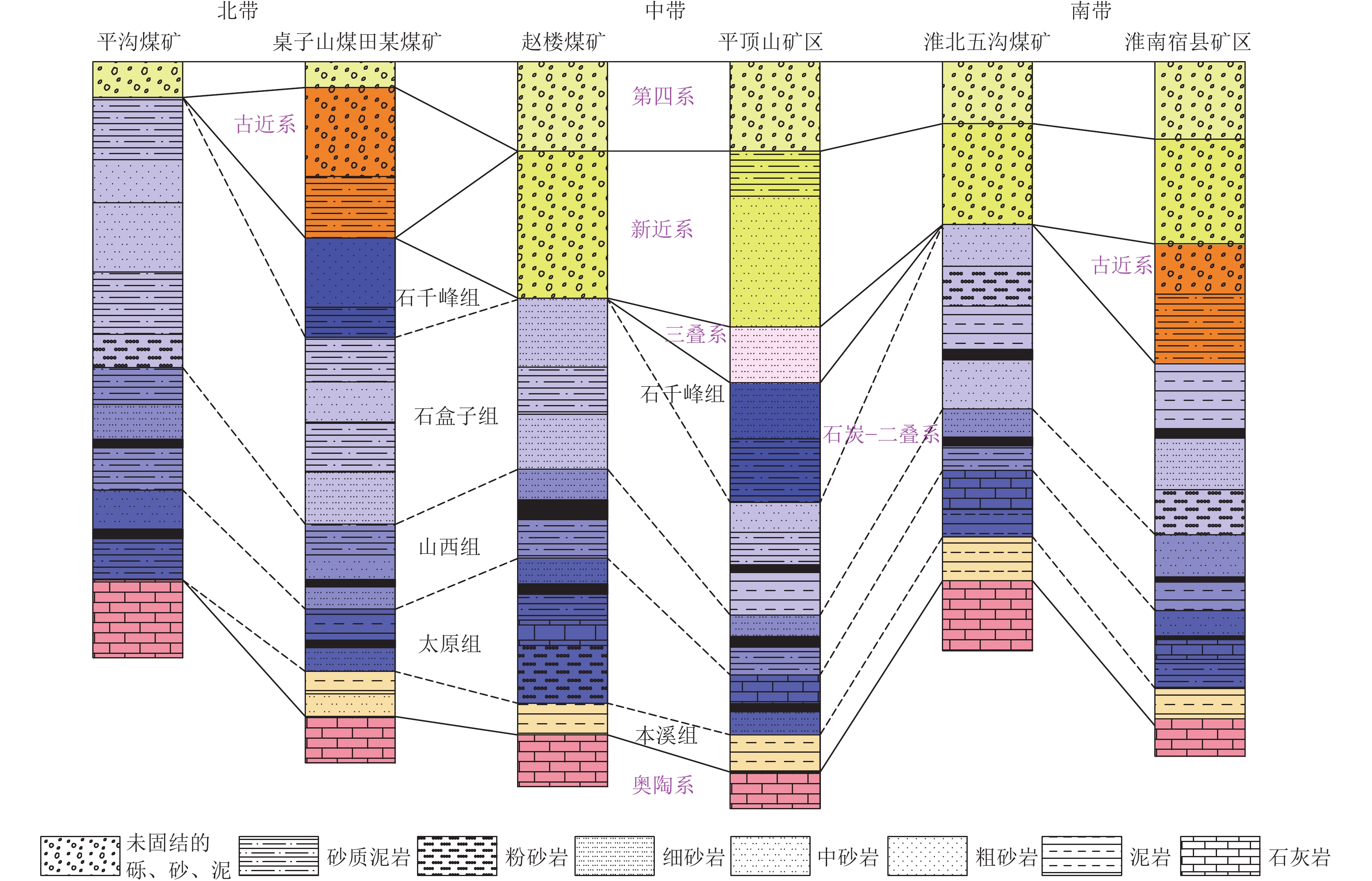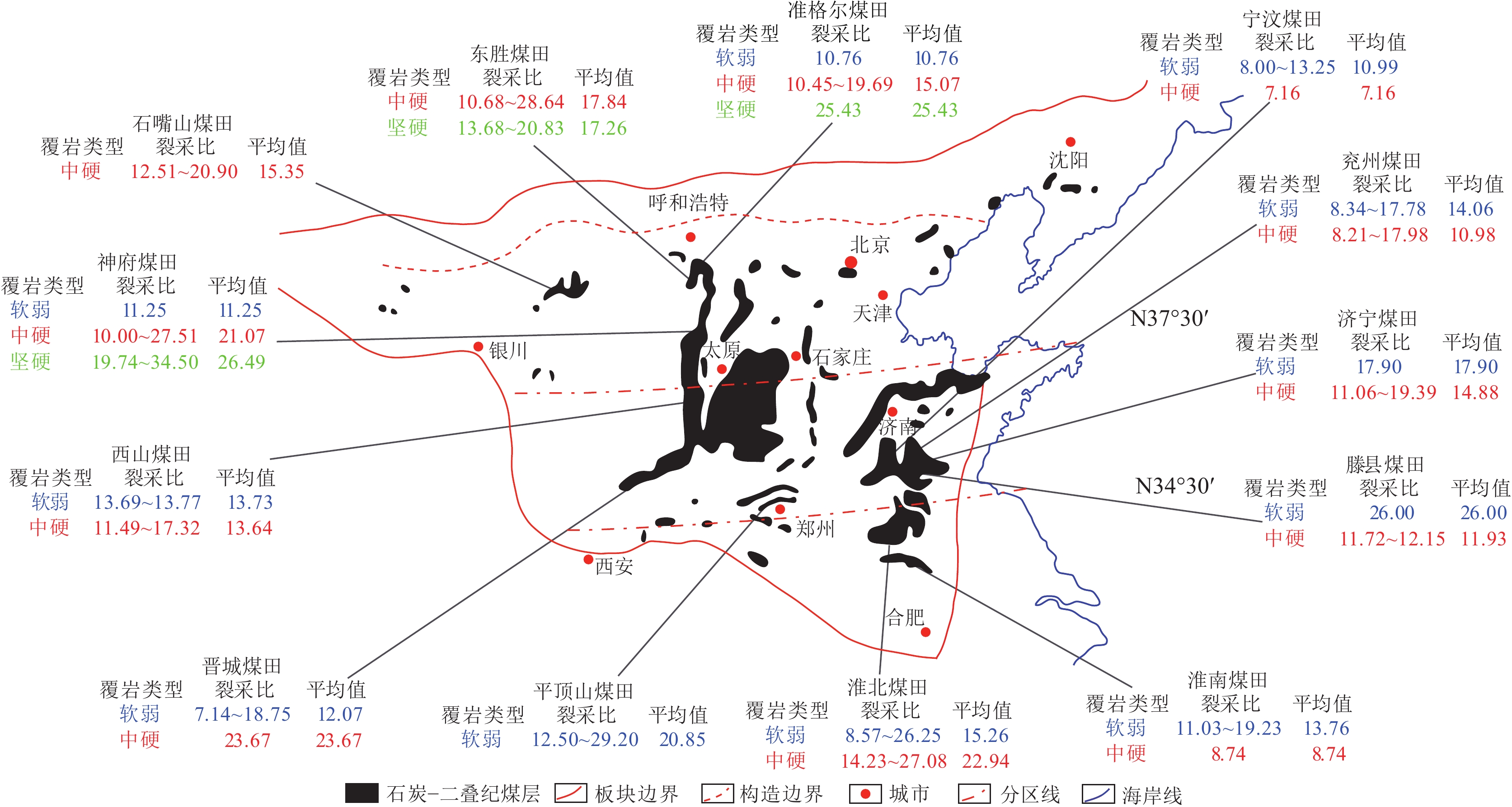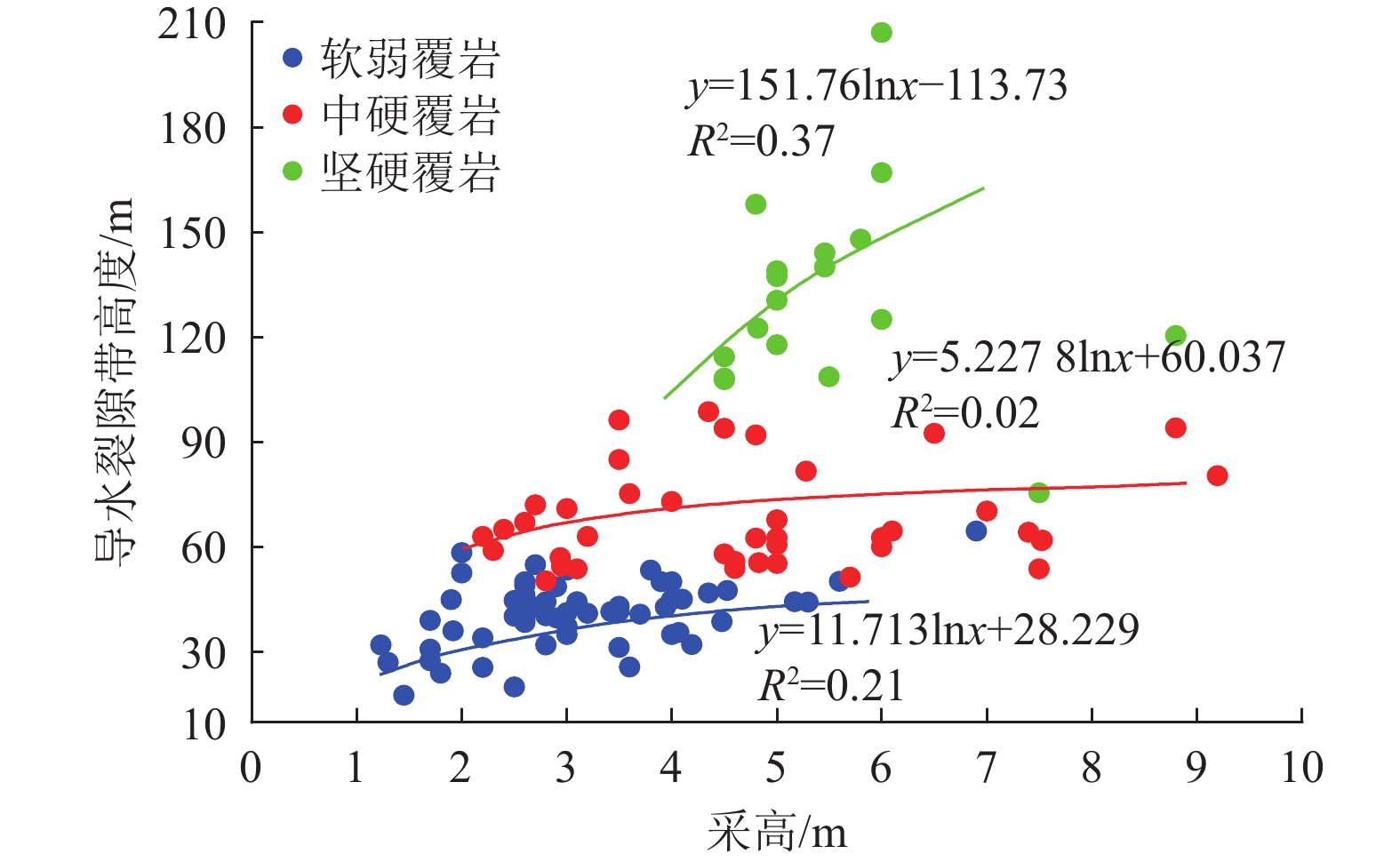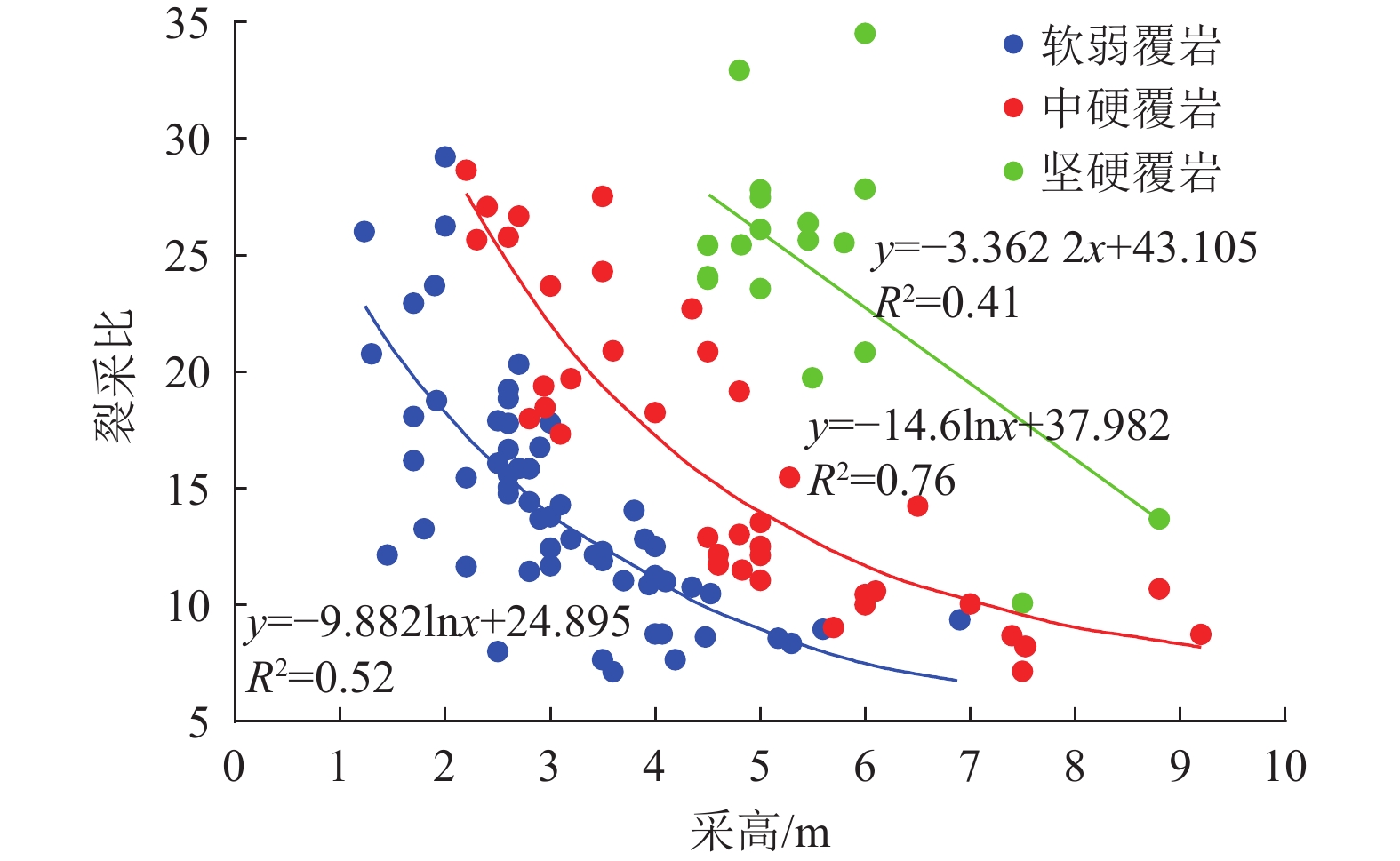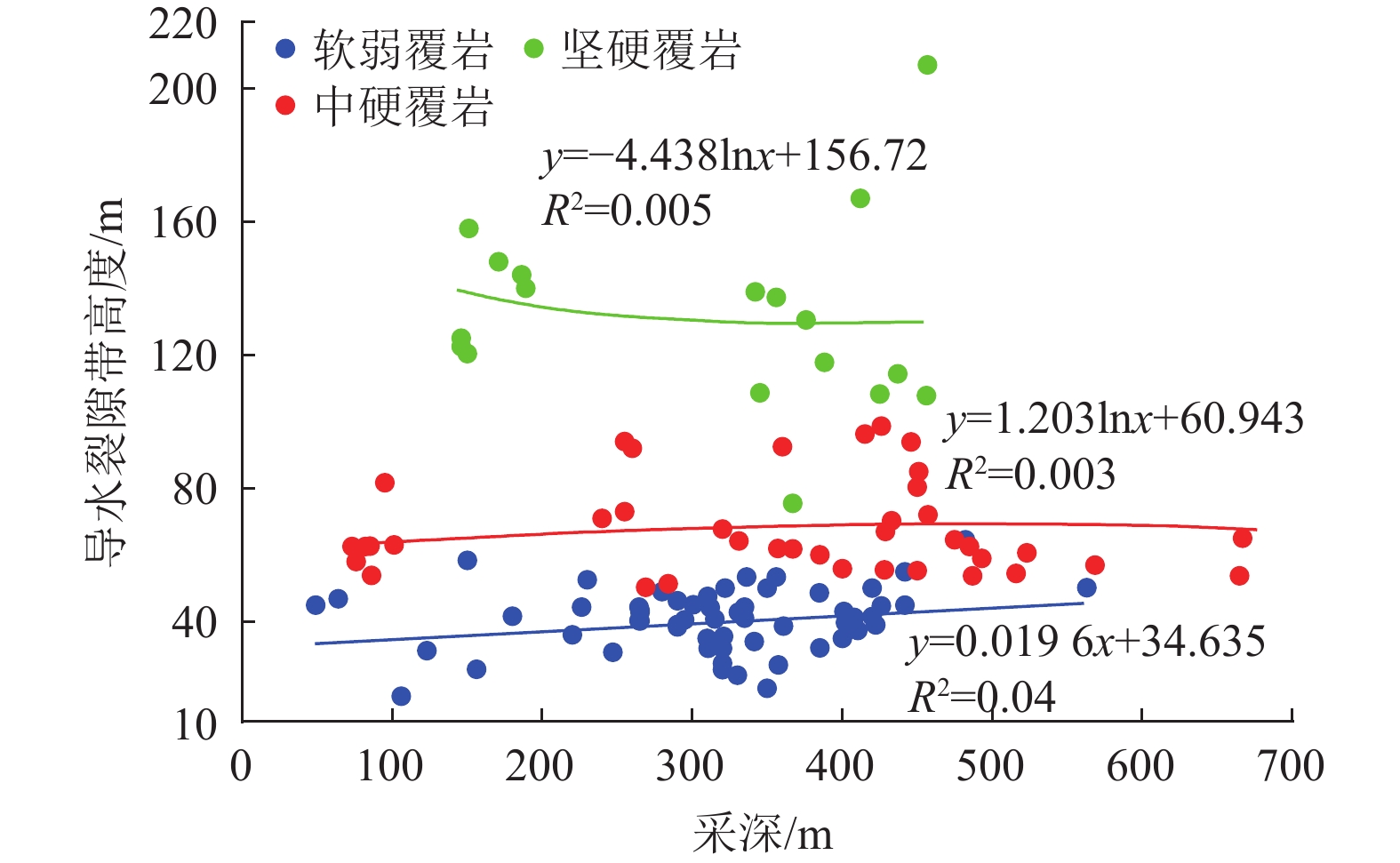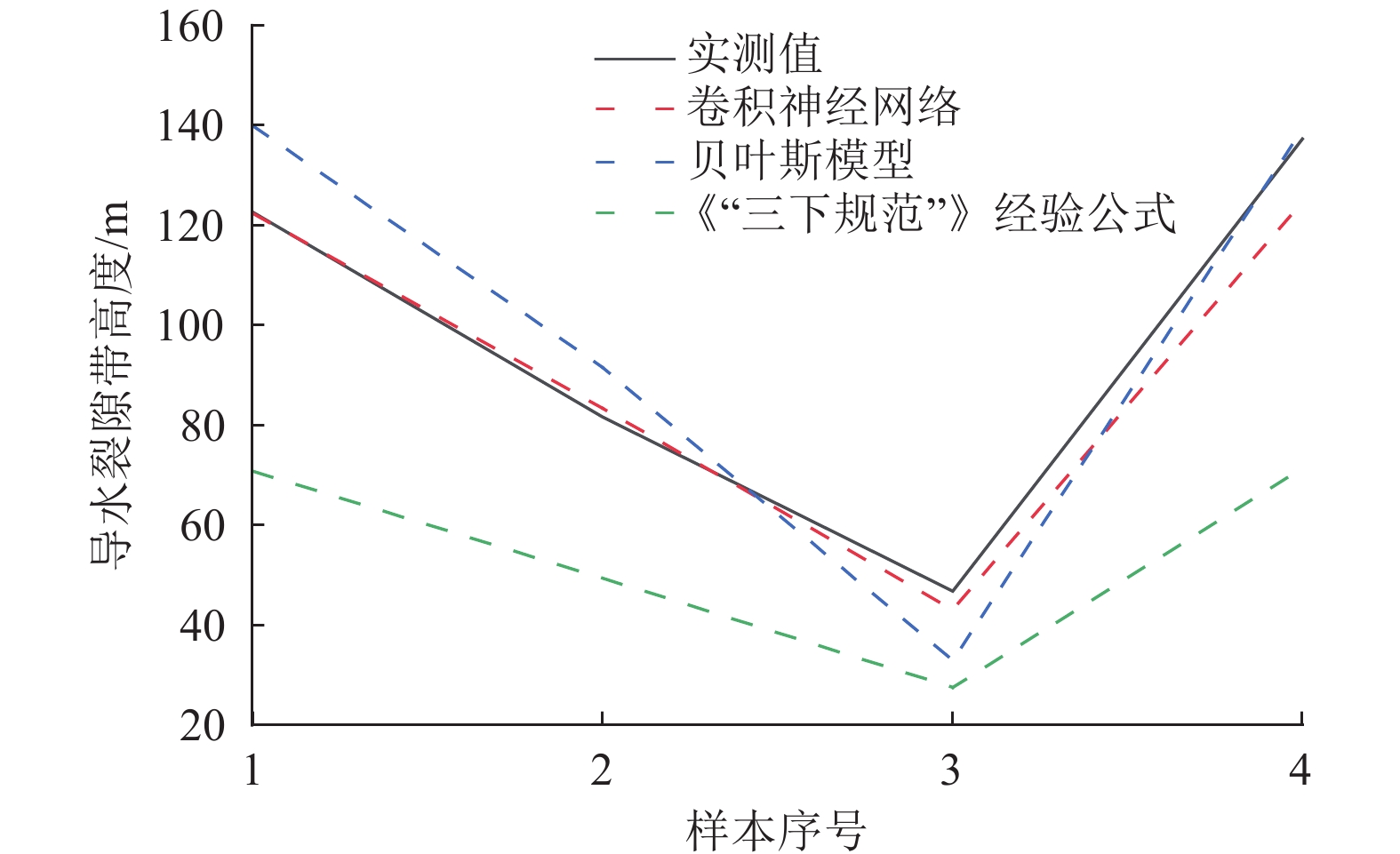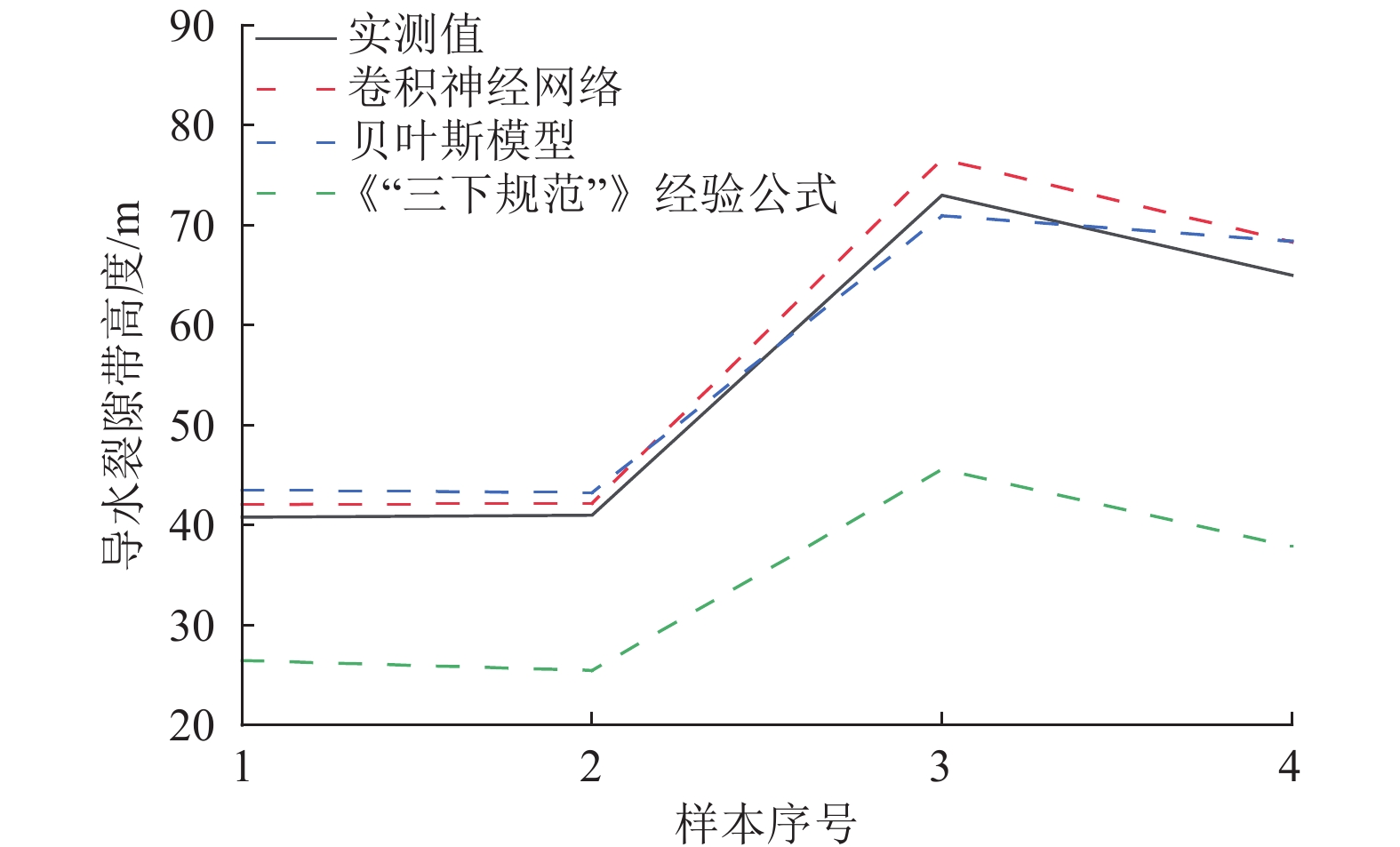Zonal prediction of the heights of water-conducting fracture zones under varying overburden types in North China-type coalfields
-
摘要:背景
我国华北型煤田煤炭资源开采深度及开采强度逐渐增加,进而导致覆岩移动破坏及裂隙演化等热点问题,引起极大关注。
方法收集华北型煤田导水裂隙带高度实测数据共117组,其中不同覆岩类型(坚硬、中硬和软弱)数据分别为17、42和58组。在此基础上探究不同覆岩类型控制下不同采高、不同采深以及不同工作面斜长对导水裂隙带发育高度的影响。根据华北型煤田含煤地层的沉积特点,将其划分为北带、中带和南带3个区域,分别采用卷积神经网络、贝叶斯公式及《“三下”规范》3种方法,分区域开展北带、中带和南带地区的导水裂隙带高度精细化研究。
结果和结论结果表明:随着采高、采深或工作面斜长等因素的改变,不同覆岩类型条件下的导水裂隙带高度分布出现明显差异,从坚硬、中硬到软弱覆岩,裂采比依次降低,其中坚硬覆岩的裂采比是中硬覆岩的1.59倍,是软弱覆岩的1.77倍;中硬覆岩的裂采比是软弱覆岩的1.11倍。预测结果显示,3个地区卷积神经网络和贝叶斯公式的RMSE(ERMS)值分别为6.62和21.84、2.20和8.09、2.60和6.12,明显小于《“三下”规范》中的经验公式的RMSE(ERMS)值(45.91、13.40和21.99),说明卷积神经网络和贝叶斯公式的预测结果均优于经验公式,其中卷积神经网络预测结果更为贴近实测结果,具有良好的适用性,可为华北型煤田不同覆岩类型下的导水裂隙带高度预测提供依据。
Abstract:BackgroundThe gradual increase in the exploitation depth and intensity of coal resources in the North China-type coalfields has caused problems such as overburden movement and damage, as well as fracture evolution. These hot topics have attracted considerable attention.
MethodsA total of 117 sets of measured data on the heights of water-conducting fracture zones in the North China-type coalfields were collected, consisting of 17 sets from hard overburden, 42 sets from moderately hard overburden, and 58 sets from soft overburden. Using these data, this study explored the effects of varying mining heights, mining depths, and lengths of the mining face along its dip direction on the heights of water-conducting fracture zones under varying overburden types. Given the sedimentary characteristics of their coal-bearing strata, the North China-type coalfields were divided into three regions: the northern, middle, and southern belts. This study thoroughly investigated the heights of water-conducting fracture zones in the three regions using the convolutional neural network, the Bayes' formula, and empirical formulas for coal mining under buildings, water bodies, and railways.
Results and ConclusionsThe results indicate that as the mining height, mining depth, or the length of the mining face along its dip direction varied, the height distributions of water-conducting fracture zones differed significantly under different overburden types. From hard, to medium-hard, and then to soft overburden types, the ratio of the height of water-conducting fracture zones to the mining height (also referred to as the fracture-to-mining ratio) decreased sequentially. Specifically, the fracture-to-mining ratio of hard overburden was 1.59 times that of moderately hard overburden and 1.77 times that of soft overburden, while the fracture-to-mining ratio of moderately hard overburden was 1.11 times that of soft overburden. The prediction results indicate that the prediction results of the northern, middle, and southern belts calculated using the convolutional neural network yielded root mean square errors (RMSEs) of 6.62, 2.20, and 2.60, respectively, while those calculated using Bayes’ formula yielded RMSEs of 21.84, 8.09, and 6.12, respectively. These values were much less than those derived using the empirical formulas for coal mining under buildings, water bodies, and railways (45.91, 13.40, and 21.99, respectively). This suggests that the convolutional neural network and Bayes’ formula outperform the empirical formulas. Notably, the prediction results obtained using the convolutional neural network are closer to the measured results, suggesting the high suitability of the convolutional neural network. This study can provide a basis for predicting the heights of water-conducting fracture zones under different overburden types in the North China-type coalfields.
-
-
表 1 各煤田导水裂隙带数据汇总
Table 1 Summary of data on water-conducting fracture zones in various coalfields
煤田 矿井 覆岩
类型采高/m 采深/m 工作
面斜长/m导水裂隙带
实测高度/m煤田 矿井 覆岩
类型采高/m 采深/m 工作面
斜长/m导水裂隙带
实测高度/m神府煤田 大柳塔 软弱 4 49 135 45 东胜煤田 乌兰木伦 中硬 2.2 101 158 63 榆阳矿 中硬 3.5 126 212 96.3 乌兰木伦 3.2 56 158 63 榆阳矿 3.5 105 200 85 补连塔 4.8 260 208 92 杭来湾 4.5 122 215 93.87 上湾矿 8.8 102 300 94 柠条塔 4.35 116 295 98.68 塔然高勒 4.5 76 279.5 58 榆神矿 6 86 140 60 补连塔矿 坚硬 6 146 311 125 金鸡滩 坚硬 5.5 134 220 108.59 上湾矿 8.8 150 300 120.4 榆树湾 5 156 240 130.5 晋城煤田 赵固一矿 软弱 3.5 180 141 41.6 榆树湾 5 153 242 137.3 常村矿 3.5 123 100 31.26 榆树湾 5 161 246 138.9 赵屋矿 4.19 385 130 32.05 榆树湾 5 145 238 117.8 七一矿 1.7 247 126 30.74 杭来湾 4.5 129 226 108.32 晋城某矿 3.6 156 110 25.7 杭来湾 4.5 142 236 114.38 盖州矿 1.92 220 100 36 杭来湾 4.5 126 220 107.83 古汉山 中硬 3 240 152 71 曹家滩 6 330 350 167 宁汶煤田 鲁西矿 软弱 2.5 350 135 20 曹家滩 6 260 280 207 鲁西矿 3.42 420 160 41.51 柠条塔 4.8 150.91 110 158 大封矿 1.45 106 215 17.6 柠条塔 5.8 171 286 148 太平矿 1.8 330 129 23.85 柠条塔 5.46 186.1 269 144 太平矿 2.2 320 122 25.6 柠条塔 5.46 188.91 273 140 东滩矿 4 400 30 35 淮南煤田 丁集矿 软弱 3.7 315 245 40.8 阳城矿 中硬 7.5 665 222 53.7 丁集矿 2.6 420 253.4 50 济宁煤田 新河矿 软弱 2.5 426 110 44.75 新集矿 3.8 356 193 53.4 新河矿 中硬 5 450 160 55.3 潘三矿 3 310 250 35 济三矿 6.1 475 170 64.6 潘三矿 3.9 350 240 50 济二矿 2.94 568.4 180.4 57 昌恒矿 中硬 9.2 450 200 80.4 济二矿 2.95 516 206.1 54.5 兖州煤田 鲍店矿 软弱 6.9 482 135 64.5 淮北煤田 童亭矿 软弱 2 230 85 52.5 鲍店矿 5.6 563 188 50.18 杨庄矿 1.7 320 65 27.5 兴隆庄 2.8 264.5 156 44.34 五沟矿 4.48 360.7 180 38.65 兴隆庄 2.6 265 147 43.34 五沟矿 5.17 335 135 44.3 兴隆庄 2.8 264.5 148.5 40.35 五沟矿 3.94 330.91 180 42.8 兴隆庄 2.6 290 168 46.22 五沟矿 4.07 321 175 35.6 兴隆庄 2.6 290 168 38.41 五沟矿 4.53 310.21 180 47.5 兴隆庄 2.6 290 168 39.14 五沟矿 3.2 335 182.8 41 兴隆庄 2.5 265 192 40.21 五沟矿 3.1 226.2 137.5 44.3 兴隆庄 2.7 265 192 42.81 谢桥矿 2.6 280 112 49 兴隆庄 2.6 295 185 40.5 祁东矿 3 410.5 125.2 37.3 兴隆庄 5.3 312 145.7 44.2 祁东矿 1.7 422.3 182.7 39 鲍店矿 中硬 7.53 357 170 61.9 祁东矿 1.9 441.7 173.8 45 鲍店矿 7.52 367 190 61.77 祁东矿 2.7 441.8 56.3 54.9 南屯矿 5 320 122 67.7 祁东矿 2.9 384.9 168.7 48.6 南屯矿 4.8 485 175 62.5 桃园矿 3 336.1 158.6 53.4 兴隆庄 2.8 269 156 50.34 祁南矿 2.8 310.5 173.8 32 兴隆庄 7 433 168 70.3 祁南矿 1.3 357.3 195.8 27 兴隆庄 7.4 331 160 64.25 孙瞳矿 2.2 341.5 192.4 34 兴隆庄 5.7 283.9 177.9 51.4 袁二矿 4.1 300.8 201.8 45.1 鲍店矿 7.5 367 173.5 75.5 袁二矿 3.5 401.2 144.9 43 西山煤田 官庄河 软弱 2.9 402 140 39.7 祁东矿 中硬 2.4 667 153.4 65 曙光矿 3 408 120 41.3 祁东矿 2.7 457.2 181 72 东曲矿 中硬 4.83 428 226 55.5 祁东矿 2.3 493.1 184 59 官庄河 3.1 487 220 53.7 祁东矿 2.6 428.9 127.3 67 恒昇矿 5 523 200 60.6 青东矿 6.5 360 200 92.5 石嘴山煤田 红柳矿 中硬 5.28 95 306 81.66 板集矿 4 255 262 73 麦垛山 3.6 74 250 75.25 滕县煤田 留庄矿 软弱 1.23 320 90 31.98 红柳矿 5 82 302 62.53 高庄矿 中硬 4.6 400 170 55.9 宁夏某矿 5 73 306 62.53 高庄矿 4.6 86.1 170 53.9 准格尔煤田 门克庆矿 软弱 4.35 64 106 46.8 平顶山煤田 云盖山二矿 软弱 4 322 133 50 红庆河 中硬 6 85 246 62.7 平煤股份八矿 2 150 174 58.4 母杜柴登 坚硬 4.82 146 280 122.57 表 2 华北型煤田划分
Table 2 Division of North China-type coalfields
分区 煤田 沉积环境 北带 神府煤田、石嘴山煤田、东胜煤田、准格尔煤田 滨海冲积平原和山前冲积平原 中带 宁汶煤田、兖州煤田、济宁煤田、滕县煤田、平顶山煤田、晋城煤田、西山煤田 滨海平原和滨海冲积平原等过渡地带 南带 淮南煤田、淮北煤田 滨海环境 表 4 不同覆岩类型下导水裂隙带高度和裂采比
Table 4 Heights and fracture-to-mining ratios of water-conducting fracture zones under varying overburden types
覆岩类型 采高/m 导水裂隙带高度/m 裂采比 坚硬 $\dfrac{4.50 \sim 8.80}{5.42} $ $\dfrac{107.83 \sim 207.00}{135.03} $ $\dfrac{13.68 \sim 34.50}{25.34} $ 中硬 $\dfrac{2.20 \sim 9.20}{4.88} $ $\dfrac{50.34 \sim 98.68}{60.07} $ $\dfrac{7.16 \sim 28.64}{15.92} $ 软弱 $\dfrac{1.23 \sim 6.90}{3.11} $ $\dfrac{17.60 \sim 64.50}{40.77} $ $\dfrac{7.14 \sim 29.20}{14.34} $ 注:4.50~8.80表示最小~最大值;横线下侧数据5.42表示平均值,其他同。 表 5 覆岩类型数值量化
Table 5 Quantization of overburden types
变量类型 变量名称 变量取值 覆岩类型 坚硬 0.75 中硬 0.50 软弱 0.25 表 6 《“三下”规范》经验公式
Table 6 Empirical formulas for coal mining under buildings, water bodies, and railways
岩性 公式一 公式二 坚硬 $ {H_{{\text{li}}}} = \dfrac{{100\displaystyle\sum M }}{{1.2\displaystyle\sum M + 2.0}} \pm 8.9 $ $ {H_{{\text{li}}}} = 30\sqrt {\displaystyle\sum M } + 10 $ 中硬 $ {H_{{\text{li}}}} = \dfrac{{100\displaystyle\sum M }}{{1.6\displaystyle\sum M + 3.6}} \pm 5.6 $ $ {H_{{\text{li}}}} = 20\sqrt {\displaystyle\sum M } + 10 $ 软弱 $ {H_{{\text{li}}}} = \dfrac{{100\displaystyle\sum M }}{{3.1\displaystyle\sum M + 5.0}} \pm 4.0 $ $ {H_{{\text{li}}}} = 10\sqrt {\displaystyle\sum M } + 5 $ 表 7 实测值与其他模型预测值对比
Table 7 Comparison of measured values with predicted values from different models
单位:m 样本序号 实测值 卷积神经网络 贝叶斯模型 《“三下”规范》经验公式 预测值 绝对误差 预测值 绝对误差 预测值 绝对误差 1 122.57 122.38 −0.19 139.88 17.31 70.82 −51.75 2 81.66 83.35 1.69 91.57 9.91 49.42 −32.24 3 46.80 43.04 −3.76 32.97 −13.83 27.53 −19.27 4 137.30 124.73 −12.57 139.19 1.89 71.40 −65.90 最小误差 0.19 1.89 19.27 最大误差 12.57 17.31 65.90 RMSE (ERMS) 6.62 21.84 45.91 MAE (EMA) 4.55 17.57 42.29 R2 0.97 0.96 表 8 实测值与其他模型预测值对比
Table 8 Comparison of measured values with predicted values from different models
单位:m 样本序号 实测值 卷积神经网络 贝叶斯模型 《“三下”规范》经验公式 预测值 绝对误差 预测值 绝对误差 预测值 绝对误差 1 62.50 60.07 −2.43 59.74 −2.76 48.15 −14.35 2 50.34 53.90 3.56 53.74 3.40 40.25 −10.09 3 38.41 37.80 −0.61 38.89 0.48 23.91 −14.50 4 30.74 31.65 0.91 35.52 4.78 20.55 −10.19 5 40.21 38.12 −2.09 39.09 −1.13 23.61 −16.60 最小误差 0.61 0.48 10.09 最大误差 3.56 4.78 16.60 RMSE (ERMS) 2.20 8.09 13.40 MAE (EMA) 1.92 5.97 13.15 R2 0.93 0.97 表 9 实测值与其他模型预测值对比
Table 9 Comparison of measured values with predicted values from different models
单位:m 样本序号 实测值 卷积神经网络 贝叶斯模型 《“三下”规范》经验公式 预测值 绝对误差 预测值 绝对误差 预测值 绝对误差 1 40.80 42.08 1.28 43.49 2.69 26.47 −14.33 2 41.00 42.17 1.17 43.25 2.25 25.45 −15.55 3 73.00 76.60 3.60 70.95 −2.05 45.60 −27.40 4 65.00 68.34 3.34 68.40 3.40 37.86 −27.14 最小误差 1.17 2.05 14.33 最大误差 3.60 3.40 27.40 RMSE (ERMS) 2.60 7.22 21.99 MAE(EMA) 2.35 6.12 21.11 R2 0.97 0.97 -
[1] 施龙青,张荣遨,徐东晶,等. 基于GWO–Elman神经网络的底板突水预测[J]. 煤炭学报,2020,45(7):2455−2463. SHI Longqing,ZHANG Rongao,XU Dongjing,et al. Prediction of water inrush from floor based on GWO–Elman neural network[J]. Journal of China Coal Society,2020,45(7):2455−2463.
[2] 施龙青,辛恒奇,翟培合,等. 大采深条件下导水裂隙带高度计算研究[J]. 中国矿业大学学报,2012,41(1):37−41. SHI Longqing,XIN Hengqi,ZHAI Peihe,et al. Calculating the height of water flowing fracture zone in deep mining[J]. Journal of China University of Mining & Technology,2012,41(1):37−41.
[3] 国家安全监管总局,国家煤矿安监局,国家能源局,等. 建筑物、水体、铁路及主要井巷煤柱留设与压煤开采规范[M]. 北京:煤炭工业出版社,2017. [4] 王永国,王明,许蓬. 巴彦高勒煤矿3-1煤层顶板垮落裂缝带发育特征[J]. 煤田地质与勘探,2019,47(增刊1):37−42. WANG Yongguo,WANG Ming,XU Peng. Characteristics of collapsed fractured zone development of No.3-1 seam roof in Bayangaoler Coal Mine[J]. Coal Geology & Exploration,2019,47(Sup.1):37−42.
[5] 张云,曹胜根,郭帅,等. 含水层下短壁块段式采煤导水裂隙带高度发育规律研究[J]. 采矿与安全工程学报,2018,35(1):106−111. ZHANG Yun,CAO Shenggen,GUO Shuai,et al. Study on the height of fractured water–conducting zone under aquifer for short wall blocking mining[J]. Journal of Mining & Safety Engineering,2018,35(1):106−111.
[6] 王玮,郭玉,方忠年. 综采导水裂隙带发育高度主控因素模拟研究[J]. 矿业研究与开发,2020,40(10):51−55. WANG Wei,GUO Yu,FANG Zhongnian. Simulation on main controlling factors of development height of fully–mechanized water flowing fracture zone[J]. Mining Research and Development,2020,40(10):51−55.
[7] 曹祖宝,王庆涛. 基于覆岩结构效应的导水裂隙带发育特征[J]. 煤田地质与勘探,2020,48(3):145−151. DOI: 10.3969/j.issn.1001-1986.2020.03.021 CAO Zubao,WANG Qingtao. Development characteristics of water conducted fracture zone based on overburden structural effect[J]. Coal Geology & Exploration,2020,48(3):145−151. DOI: 10.3969/j.issn.1001-1986.2020.03.021
[8] 李蕊瑞,陈陆望,欧庆华,等. 考虑覆岩原生裂隙的导水裂隙带模拟[J]. 煤田地质与勘探,2020,48(6):179−185. DOI: 10.3969/j.issn.1001-1986.2020.06.024 LI Ruirui,CHEN Luwang,OU Qinghua,et al. Numerical simulation of fractured water–conducting zone by considering native fractures in overlying rocks[J]. Coal Geology & Exploration,2020,48(6):179−185. DOI: 10.3969/j.issn.1001-1986.2020.06.024
[9] 郭小铭,刘英锋,谷占兴. 彬长矿区煤层开采导水裂隙带高度探测及计算[J]. 采矿与岩层控制工程学报,2023,5(5):053526. GUO Xiaoming,LIU Yingfeng,GU Zhanxing. Detection and calculation of the height of water flowing fractured zone of coal roof in Binchang mining area[J]. Journal of Mining and Strata Control Engineering,2023,5(5):053526.
[10] 徐智敏,韩宇航,陈天赐,等. 侏罗系弱胶结顶板采动破坏规律与发育高度预测[J]. 工程地质学报,2023,31(4):1474−1485. XU Zhimin,HAN Yuhang,CHEN Tianci,et al. Mining–induced overburden failure and height prediction in Jurassic weakly cemented roof[J]. Journal of Engineering Geology,2023,31(4):1474−1485.
[11] 刘成勇,宋伟,盛奉天,等. 强含水层下特厚煤层综放开采导水裂隙带发育高度[J]. 采矿与岩层控制工程学报,2024,6(2):023524. LIU Chengyong,SONG Wei,SHENG Fengtian,et al. Development height of water–conducting fracture zone in fully–mechanized caving of extra–thick coal seam under strong aquifer[J]. Journal of Mining and Strata Control Engineering,2024,6(2):023524.
[12] 郭文兵,马志宝,白二虎. 我国煤矿“三下一上”采煤技术现状与展望[J]. 煤炭科学技术,2020,48(9):16−26. GUO Wenbing,MA Zhibao,BAI Erhu. Current status and prospect of coal mining technology under buildings,water bodies and railways,and above confined water in China[J]. Coal Science and Technology,2020,48(9):16−26.
[13] 耿耀强,王苏健,邓增社,等. 神府矿区大型水库周边浅埋煤层开采水害防治技术[J]. 煤炭学报,2018,43(7):1999−2006. GENG Yaoqiang,WANG Sujian,DENG Zengshe,et al. Water disaster prevention and control technology in shallow coal seam around the large reservoir in Shenfu coal mine[J]. Journal of China Coal Society,2018,43(7):1999−2006.
[14] 闫和平,李文平,段中会,等. 黄陇煤田典型特厚煤层综放开采涌水机理与导水裂隙带发育规律[J]. 煤田地质与勘探,2024,52(5):129−138. DOI: 10.12363/issn.1001-1986.23.08.0480 YAN Heping,LI Wenping,DUAN Zhonghui,et al. Water inrush mechanism and water–conducting fractured zone’ developmental patterns of a typical ultra–thick coal seam in the Huanglong coalfield during fully mechanized mining[J]. Coal Geology & Exploration,2024,52(5):129−138. DOI: 10.12363/issn.1001-1986.23.08.0480
[15] 李友伟,张玉军,肖杰. 多煤层重复采动覆岩破坏高度发育规律研究[J]. 煤炭工程,2022,54(7):97−103. LI Youwei,ZHANG Yujun,XIAO Jie. Development law of overburden failure height under repeated mining in multiple coal seams[J]. Coal Engineering,2022,54(7):97−103.
[16] 王毅,周余,张丁丁,等. 综采工作面采动覆岩导水裂隙带发育高度综合研究[J]. 矿业安全与环保,2024,51(5):132−141. WANG Yi,ZHOU Yu,ZHANG Dingding,et al. Comprehensive study on the development height of water–conducting fracture zone in overburden rock of fully mechanized mining face[J]. Mining Safety & Environmental Protection,2024,51(5):132−141.
[17] 余学义,周杨,赵兵朝,等. 水体下特厚煤层分层综放开采技术研究[J]. 煤炭工程,2011(12):4−7. YU Xueyi,ZHOU Yang,ZHAO Bingchao,et al. Research on mining technology of super thick coal seam under water[J]. Coal Engineering,2011(12):4−7.
[18] 尚慧,柳思航,甘智慧,等. 浅埋煤层群开采覆岩垮落及导水裂隙带发育规律研究[J/OL]. 水文地质工程地质,2024: 1-13 [2025-02-27]. https://doi.org/10.16030/j.cnki.issn.1000–3665.202309025. SHANG Hui,LIU Sihang,GAN Zhihui,et al. Development of overlying strata collapse and water–conducting fractured zone in shallow coal seams mining[J/OL]. Hydrogeology & Engineering Geology,2024:1-13 [2025-02-27]. https://doi.org/10.16030/j.cnki.issn.1000–3665.202309025.
[19] ZHOU Yang,YU Xueyi. Study of the evolution of water–conducting fracture zones in overlying rock of a fully mechanized caving face in gently inclined extra–thick coal seams[J]. Applied Sciences,2022,12(18):9057. DOI: 10.3390/app12189057
[20] ZHANG Dingyang,SUI Wanghua,LIU Jiawei. Overburden failure associated with mining coal seams in close proximity in ascending and descending sequences under a large water body[J]. Mine Water and the Environment,2018,37(2):322−335. DOI: 10.1007/s10230-017-0502-0
[21] 侯恩科,张萌,孙学阳,等. 浅埋煤层开采覆岩破坏与导水裂隙带发育高度研究[J]. 煤炭工程,2021,53(11):102−107. HOU Enke,ZHANG Meng,SUN Xueyang,et al. Study on overburden failure and development height of water conducting fracture zone in shallow coal seam mining[J]. Coal Engineering,2021,53(11):102−107.
[22] FANG Han,ZHU Shuyun,ZHANG Shengjun. Height development characteristics of water–conducting fracture zone in a fully mechanized longwall face with a large panel width[J]. Mining,Metallurgy & Exploration,2024,41(5):2407–2420.
[23] 李浩,白海波,马立强,等. 双系煤层采动导水裂隙演化规律的 FDEM耦合模拟研究[J]. 煤炭学报,2022,47(12):4443−4454. LI Hao,BAI Haibo,MA Liqiang,et al. Research on the evolution law of water flowing fractures in the Jurassic and Carboniferous coal seams based on FDEM simulation[J]. Journal of China Coal Society,2022,47(12):4443−4454.
[24] 徐东晶. 采动条件下拱形裂隙类岩体破坏机理及模型研究[D]. 北京:中国矿业大学(北京),2017. XU Dongjing. Research on failure mechanism of analogous rock mass having arched fractures and its model under mining conditions[D]. Beijing:China University of Mining and Technology-Beijing,2017.
[25] 张玉军,申晨辉,张志巍,等. 我国厚及特厚煤层高强度开采导水裂缝带发育高度区域分布规律[J]. 煤炭科学技术,2022,50(5):38−48. ZHANG Yujun,SHEN Chenhui,ZHANG Zhiwei,et al. Regional distribution law of water–conducting fractured zone height in high–strength mining of thick and extra–thick coal seams in China[J]. Coal Science and Technology,2022,50(5):38−48.
[26] GUO Wenbing,ZHAO Gaobo,LOU Gaozhong,et al. A new method of predicting the height of the fractured water–conducting zone due to high–intensity longwall coal mining in China[J]. Rock Mechanics and Rock Engineering,2019,52(8):2789−2802. DOI: 10.1007/s00603-018-1567-1
[27] 谢道雷,江兴洪,韩承豪,等. 基于回转下沉量的导水裂隙带发育高度预测[J]. 煤矿安全,2024,55(6):176−183. XIE Daolei,JIANG Xinghong,HAN Chenghao,et al. Prediction of development height of water–conducting fracture zone based on rotational subsidence[J]. Safety in Coal Mines,2024,55(6):176−183.
[28] 谢晓锋,李夕兵,尚雪义,等. PCA–BP神经网络模型预测导水裂隙带高度[J]. 中国安全科学学报,2017,27(3):100−105. XIE Xiaofeng,LI Xibing,SHANG Xueyi,et al. Prediction of height of water flowing fractured zone based on PCA–BP neural networks model[J]. China Safety Science Journal,2017,27(3):100−105.
[29] 盛奉天,段玉清. 彬长矿区巨厚砂岩含水层下综放开采导水裂隙带高度研究[J]. 煤炭工程,2022,54(3):84−89. SHENG Fengtian,DUAN Yuqing. Height of water–conducting fracture zone in fully mechanized caving mining under extra–thick sandstone aquifer in Binchang mining area[J]. Coal Engineering,2022,54(3):84−89.
[30] 薛建坤,王皓,赵春虎,等. 鄂尔多斯盆地侏罗系煤田导水裂隙带高度预测及顶板充水模式[J]. 采矿与安全工程学报,2020,37(6):1222−1230. XUE Jiankun,WANG Hao,ZHAO Chunhu,et al. Prediction of the height of water–conducting fracture zone and water–filling model of roof aquifer in Jurassic coalfield in Ordos Basin[J]. Journal of Mining & Safety Engineering,2020,37(6):1222−1230.
[31] 郭维强. 大采高综采覆岩两带发育高度特征研究[J]. 中国安全科学学报,2022,32(增刊2):142−147. GUO Weiqiang. Study on characteristics of height of two zones of overburden caused by fully mechanized mining with large mining height[J]. China Safety Science Journal,2022,32(Sup.2):142−147.
[32] 王振广,李飞龙,白志永,等. “两软一硬”不稳定煤层工作面覆岩“两带”发育高度研究[J]. 矿业安全与环保,2020,47(1):55−60. WANG Zhenguang,LI Feilong,BAI Zhiyong,et al. Study on the height of overburden strata in two zones of “two soft and one hard” unstable coal seam working face[J]. Mining Safety & Environmental Protection,2020,47(1):55−60.
[33] 靳俊恒,孟祥瑞,高召宁,等. 1262(1)工作面导水裂隙带发育高度的数值模拟研究[J]. 煤炭工程,2010,42(11):68−70. DOI: 10.3969/j.issn.1671-0959.2010.11.027 JIN Junheng,MENG Xiangrui,GAO Zhaoning,et al. Numerical simulation study on development height of water conducted crack zone in 1262(1) coal mining face[J]. Coal Engineering,2010,42(11):68−70. DOI: 10.3969/j.issn.1671-0959.2010.11.027
[34] 吴云,李运江,孟昭河,等. 薄基岩顶分层开采“两带”发育高度研究[J]. 煤炭技术,2017,36(6):61−63. WU Yun,LI Yunjiang,MENG Zhaohe,et al. Study on development height of “two zones” in thin bedrock top slicing[J]. Coal Technology,2017,36(6):61−63.
[35] 王连国,王占盛,黄继辉,等. 薄基岩厚风积沙浅埋煤层导水裂隙带高度预计[J]. 采矿与安全工程学报,2012,29(5):607−612. WANG Lianguo,WANG Zhansheng,HUANG Jihui,et al. Prediction on the height of water–flowing fractured zone for shallow seam covered with thin bedrock and thick windblown sands[J]. Journal of Mining & Safety Engineering,2012,29(5):607−612.
[36] 李明培,邵龙义,李智学,等. 华北地区石炭–二叠纪下煤组聚煤期岩相古地理[J]. 煤炭学报,2020,45(7):2399−2410. LI Mingpei,SHAO Longyi,LI Zhixue,et al. Lithofacies palaeogeography of lower coal group accumulation period of Carboniferous Permian in North China[J]. Journal of China Coal Society,2020,45(7):2399−2410.
[37] 马亚杰,武强,章之燕,等. 煤层开采顶板导水裂隙带高度预测研究[J]. 煤炭科学技术,2008,36(5):59−62. MA Yajie,WU Qiang,ZHANG Zhiyan,et al. Research on prediction of water conducted fissure height in roof of coal mining seam[J]. Coal Science and Technology,2008,36(5):59−62.
[38] ZHAI Peihe,LI Nianzheng. Predicting the height of the hydraulic fracture zone using a convolutional neural network[J]. Mine Water and the Environment,2023,42(3):500−512. DOI: 10.1007/s10230-023-00950-6
[39] 吕纯. 谢一矿地下水化学特征及突水水源判别Elman神经网络模型[D]. 合肥:合肥工业大学,2009. LYU Chun. Chemical characteristics of groundwater and discriminate models of water bursting source based on Elman neural network:A case study on Xieyi coalmine[D]. Hefei:Hefei University of Technology,2009.
[40] 李明星. 基于CNN的地–孔TEM异常提取及PSO–DLS反演方法研究[D]. 北京:煤炭科学研究总院,2020. LI Mingxing. Research on the anomaly extraction based on CNN and PSO–DLS inversion of the downhole TEM method[D]. Beijing:China Coal Research Institute,2020.
-
期刊类型引用(14)
1. 王大兴,胡海燕,邹佳群,王涛,朱根根,陈笑宇,梁烁. 准噶尔盆地东道海子凹陷二叠系下乌尔禾组陆相页岩气形成富集条件及主控因素. 地质科技通报. 2024(04): 98-112 .  百度学术
百度学术
2. 任诺,宋怀雷,杨超,王文涛. 页岩在水压致裂过程中破裂规律的数值模拟研究. 水利规划与设计. 2023(01): 101-107 .  百度学术
百度学术
3. 邱凯旋,李恒,郝世彦,张丽霞,唐永槐,马玉珊. 含砂岩薄互层陆相页岩气藏生产预测模型研究. 非常规油气. 2023(01): 111-121 .  百度学术
百度学术
4. 李泽帆,陈相霖,李树刚,郭睿良,李泳,刘鹏. 高—过成熟页岩CH_4/N_2/CO_2混合气体竞争吸附特征与地质意义. 天然气地球科学. 2023(01): 169-180 .  百度学术
百度学术
5. 魏若飞,信凯. 鄂尔多斯盆地东缘石西区块煤层气及致密砂岩气资源潜力评价. 中国煤炭地质. 2022(07): 7-11+38 .  百度学术
百度学术
6. 李海,赵昌杰,王文涛. 不同层理倾角与石英含量下页岩破裂过程数值试验研究. 水利规划与设计. 2022(11): 108-113+167 .  百度学术
百度学术
7. 李浩. 延长探区南部盒8段稀土元素地球化学示踪. 云南化工. 2021(06): 129-132 .  百度学术
百度学术
8. 陆雨诗,胡勇,侯云东,孙继峰,何文祥,高小洋,司锦,宋雯馨. 鄂尔多斯盆地西缘羊虎沟组微量元素地球化学特征及沉积环境指示意义. 科学技术与工程. 2021(28): 11999-12009 .  百度学术
百度学术
9. 客昆,秦建华,牟必鑫,余谦,魏洪刚,郝学峰,陈杨,客达,周家云,龚大兴. 楚雄盆地上三叠统舍资组泥页岩储层特征分析——以滇禄地3井为例. 科学技术与工程. 2021(28): 12020-12030 .  百度学术
百度学术
10. 娄义黎,邬忠虎,王安礼,左宇军,刘镐,孙文吉斌. 流固耦合作用下页岩破裂过程的数值模拟. 煤田地质与勘探. 2020(01): 105-112 .  本站查看
本站查看
11. 王羽,汪丽华,王建强,王彦飞. 利用微米X射线显微镜研究陆相延长组页岩孔隙结构特征. 岩矿测试. 2020(04): 566-577 .  百度学术
百度学术
12. 和钰凯,李贤庆,魏强,张学庆,邹晓艳,张亚超,李阳阳. 淮南潘谢矿区石盒子组煤系页岩气储层孔隙结构特征及影响因素. 科学技术与工程. 2020(33): 13618-13627 .  百度学术
百度学术
13. 孙细宁,陈奕奕,王桂成,姜呈馥,许小强. 延长探区陆相页岩气产能影响因素分析. 复杂油气藏. 2019(04): 8-14 .  百度学术
百度学术
14. 景丰. 陆相页岩气水平井中增韧防气窜固井水泥浆体系的研究. 石油化工应用. 2018(07): 5-10 .  百度学术
百度学术
其他类型引用(5)







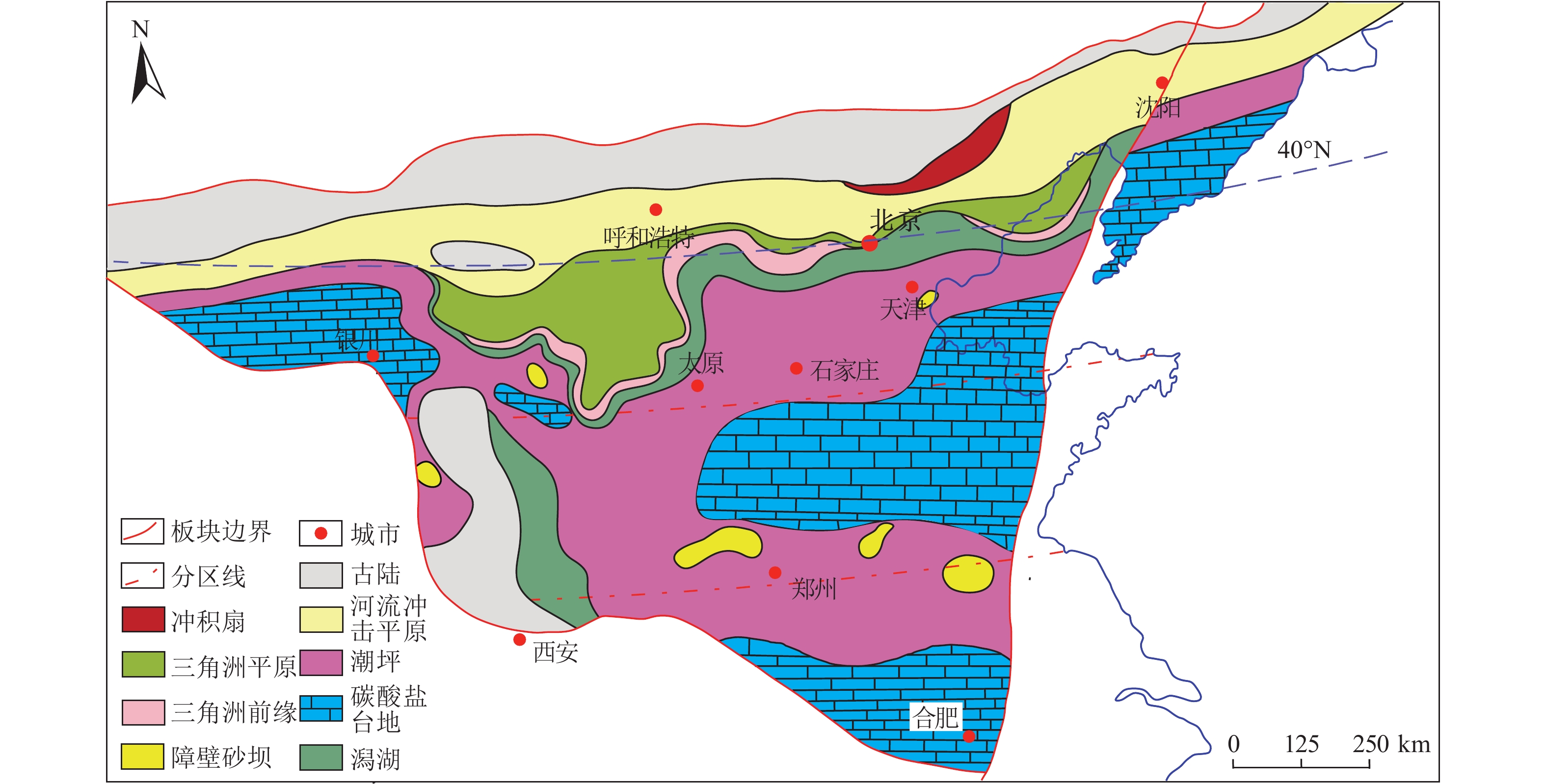
 下载:
下载:
